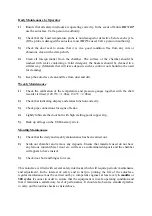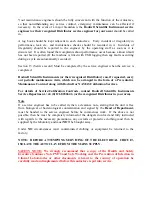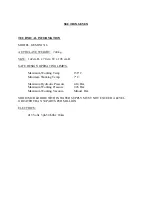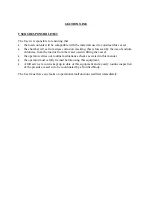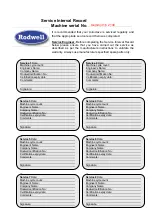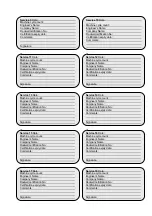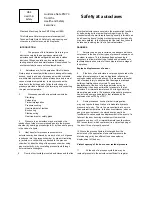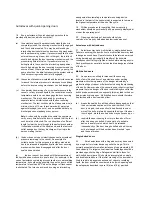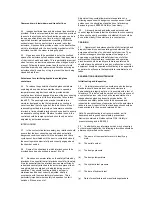
on the pressure gauge but which, acting over the surface area
of the door, may exert considerable force. For example a
pressure of 0.1 bar acting on a door of 2 m diameter would
produce a thrust of more than 3 tonnes which could, unless
suitable precautions were taken, cause the door to open
violently on release of its securing mechanism, thereby putting
the operator at serious risk of injury. It is also possible that the
door seal may adhere to the mating face of the autoclave
causing the door to stick in position after the securing
mechanism has been disengaged. The door might then open
violently and unexpectedly with or without further disturbance
of the door by the operator.
12
When the contents of the autoclave are wholly or
partly liquid the operator may be scalded or engulfed by
vapour, boiling or hot liquid when:
(a) the door is opened while the temperature of the liquid is
at or above its boiling point corresponding to
atmospheric pressure. The reduction in pressure causes
the hot liquid to flash violently into vapour, leading to an
eruption of the fluid contents of the vessel;
(b) the door is opened and the hot liquid contents overflow
(eg from horizontal vessels not completely drained or
vertical vessels filled above the level of the opening
rim);
(c) hot liquid is retained undetected under the lid in vertical
vessels where venting is not fully effective.
(d) steam at pressure inadvertently enters an autoclave
from another autoclave or a transfer pipe;
(e) hot liquid and/or steam enters an autoclave from a
blowdown tank through a common blowdown pipe while
the operator is inside the autoclave (para 24).
Explosion of sealed glass containers
13 There is a risk of injury to persons when liquids in sealed
glass containers are sterilised in an autoclave. The risk
occurs when the autoclave door is opened and the
temperature of the contents of the containers has not
been sufficiently reduced below the atmospheric boiling
temperature. Rapid pressure reduction in the autoclave
and thermal shock to the load may cause explosion and
fragmentation of the containers and violent eruption of
the contents at scalding temperatures.
SAFEGUARDS
Design
14
All parts of an autoclave, its foundations and
supporting structures should be properly designed, of good
construction, sound material and adequate strength. The
requirements for access and inspection should be considered
at the design and construction stages. It is recommended that
BS 470
Inspection, access and entry openings for pressure
vessels
be used to establish minimum requirements.
15
Recognised Standards should be used for the
design and construction of autoclaves. The main
relevant British Standards are:
BS 5500
Unfired fusion welded pressure vessels.
BS 3970
Autoclaves for sterilizing and disinfecting
medical products.
BS 2646
Autoclaves for sterilization in
laboratories.
BS 1746
Specification for domestic pressure
cookers.
Other standards or designs may be used if they provide an
equivalent or higher standard of safety.
Note:
BS 1746 is included as some pressure cookers of this
type are used at work; it should only be taken to apply to
vessels within its scope and should be used to determine the
type and characteristics of safety devices etc which should be
fitted.
Fittings
16
Every autoclave should be provided with the
following fittings:
(a)
A suitable safety valve set to prevent the vessel
being over- pressurised. Discharge from this device
should be to a place where it is visible and/or
audible and cannot injure any person.
(b)
A suitable reducing valve or other suitable automatic
appliance to prevent the safe working pressure being
exceeded when an autoclave is not designed to
withstand the pressure at source.
(c)
A suitable isolating or stop valve in the inlet line.
This device is additional to any door interlocked
valve.
(d) A correct and suitable pressure indicating device
installed where it can be easily observed by the
operator.
(e) Suitable drains particularly on pipework at
positions where sediment or water is liable to
accumulate.
Markings
17
The user should permanently and clearly
mark each autoclave with a plant identification number
where more than one is installed, and every autoclave
should be permanently marked clearly and visibly with
its maximum permissible working pressure. In addition,
autoclaves, in which the process fluid is a liquid at an
elevated temperature, should be marked with the
maximum operating temperature, clearly shown on the
temperature indicating device.



